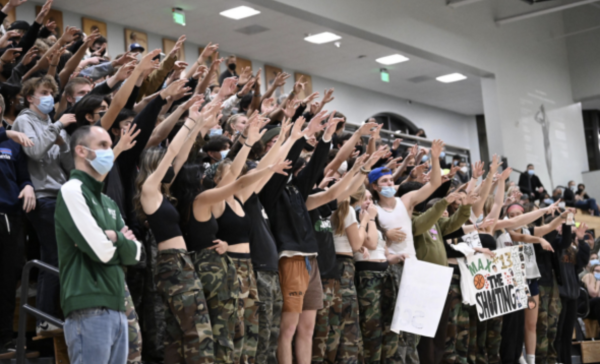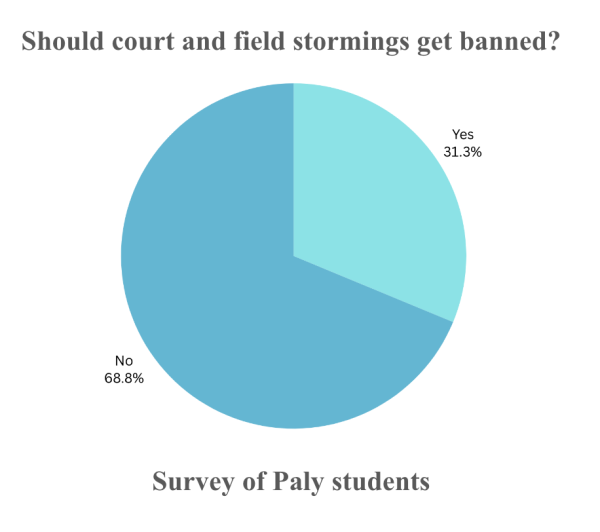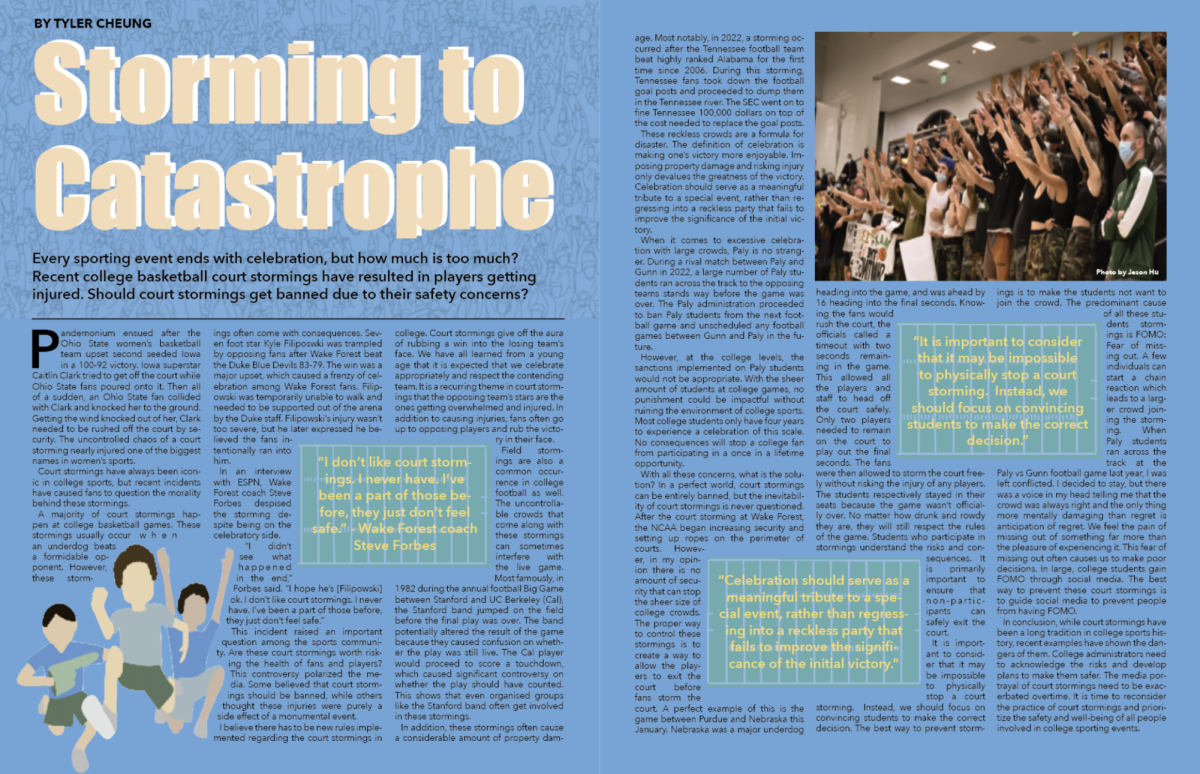Pandemonium ensued after the Ohio State women’s basketball team upset second seeded Iowa in a 100-92 victory. Iowa superstar Caitlin Clark tried to get off the court while Ohio State fans poured onto it. Then all of a sudden, an Ohio State fan collided with Clark and knocked her to the ground. Getting the wind knocked out of her, Clark needed to be rushed off the court by security. The uncontrolled chaos of a court storming nearly injured one of the biggest names in women’s sports.
Court stormings have always been iconic in college sports, but recent incidents have caused fans to question the morality behind these stormings.
A majority of court stormings happen at college basketball games. These stormings usually occur when an underdog beats a formidable opponent. However, these stormings often come with consequences. Seven foot star Kyle Filiposwki was trampled by opposing fans after Wake Forest beat the Duke Blue Devils 83-79. The win was a major upset, which caused a frenzy of celebration among Wake Forest fans. Filipowski was temporarily unable to walk and needed to be supported out of the arena by the Duke staff. Filipowski’s injury wasn’t too severe, but he later expressed he believed the fans intentionally ran into him.
In an interview with ESPN, Wake Forest coach Steve Forbes despised the storming despite being on the celebratory side.
“I didn’t see what happened in the end,” Forbes said. “I hope he’s [Filipowski] ok. I don’t like court stormings. I never have. I’ve been a part of those before, they just don’t feel safe.”
This incident raised an important question among the sports community. Are these court stormings worth risking the health of fans and players? This controversy polarized the media. Some believed that court stormings should be banned, while others thought these injuries were purely a side effect of a monumental event.
I believe there has to be new rules implemented regarding the court stormings in college. Court stormings give off the aura of rubbing a win into the losing team’s face. We have all learned from a young age that it is expected that we celebrate appropriately and respect the contending team. It is a recurring theme in court stormings that the opposing team’s stars are the ones getting overwhelmed and injured. In addition to causing injuries, fans often go up to opposing players and rub the victory in their face.
Field stormings are also a common occurrence in college football as well. The uncontrollable crowds that come along with these stormings can sometimes interfere with the live game. Most famously, in 1982 during the annual football Big Game between Stanford and UC Berkeley (Cal), the Stanford band jumped on the field before the final play was over. The band potentially altered the result of the game because they caused confusion on whether the play was still live. The Cal player would proceed to score a touchdown, which caused significant controversy on whether the play should have counted. This shows that even organised groups like the Stanford band often get involved in these stormings.
In addition, these stormings often cause a considerable amount of property damage. Most notably, in 2022, a storming occurred after the Tennessee football team beat highly ranked Alabama for the first time since 2006. During this storming, Tennessee fans took down the football goal posts and proceeded to dump them in the Tennessee river. The SEC went on to fine Tennessee 100,000 dollars on top of the cost needed to replace the goal posts.
These reckless crowds are a formula for disaster. The definition of celebration is making one’s victory more enjoyable. Imposing property damage and risking injury only devalues the greatness of the victory. Celebration should serve as a meaningful tribute to a special event, rather than regressing into a reckless party that fails to improve the significance of the initial victory.
When it comes to excessive celebration with large crowds, Paly is no stranger. During a rival match between Paly and Gunn in 2022, a large number of Paly students ran across the track to the opposing teams stands way before the game was over. The Paly administration proceeded to ban Paly students from the next football game and unscheduled any football games between Gunn and Paly in the future.
However, at the college levels, the sanctions implemented on Paly students would not be appropriate. With the sheer amount of students at college games, no punishment could be impactful without ruining the environment of college sports. Most college students only have four years to experience a celebration of this scale. No consequences will stop a college fan from participating in a once in a lifetime opportunity.
With all these concerns, what is the solution? In a perfect world, court stormings can be entirely banned, but the inevitability of court stormings is never questioned. After the court storming at Wake Forest, the NCAA began increasing security and setting up ropes on the perimeter of courts. However, in my opinion there is no amount of security that can stop the sheer size of college crowds. The proper way to control these stormings is to create a way to allow the players to exit the court before fans storm the court. A perfect example of this is the game between Purdue and Nebraska this January. Nebraska was a major underdog heading into the game, and was ahead by 16 heading into the final seconds. Knowing the fans would rush the court, the officials called a timeout with two seconds remaining in the game. This allowed all the players and staff to head off the court safely. Only two players needed to remain on the court to play out the final seconds. The fans were then allowed to storm the court freely without risking the injury of any players. The students respectively stayed in their seats because the game wasn’t officially over. No matter how drunk and rowdy they are, they will still respect the rules of the game. Students who participate in stormings understand the risks and consequences. It is primarily important to ensure that non-participants can safely exit the court.
It is important to consider that it may be impossible to physically stop a court storming. Instead, we should focus on convincing students to make the correct decision. The best way to prevent stormings is to make the students not want to join the crowd. The predominant cause of all these students stormings is FOMO: Fear of missing out. A few individuals can start a chain reaction which leads to a larger crowd joining the storming. When Paly students ran across the track at the Paly vs Gunn football game last year, I was left conflicted. I decided to stay, but there was a voice in my head telling me that the crowd was always right and the only thing more mentally damaging than regret is anticipation of regret. We feel the pain of missing out of something far more than the pleasure of experiencing it. This fear of missing out often causes us to make poor decisions. In large, college students gain FOMO through social media. The best way to prevent these court stormings is to guide social media to prevent people from having FOMO.
In conclusion, while court stormings have been a long tradition in college sports history, recent examples have shown the dangers of them. College administrators need to acknowledge the risks and develop plans to make them safer. The media portrayal of court stormings need to be exacerbated overtime. It is time to reconsider the practice of court stormings and prioritize the safety and well-being of all people involved in college sporting events.
Link to discussion with Paly students:
https://drive.google.com/file/d/15RP6mlOXozj7DqhMJvFLfGnmXhOKlxvI/view?usp=sharing




